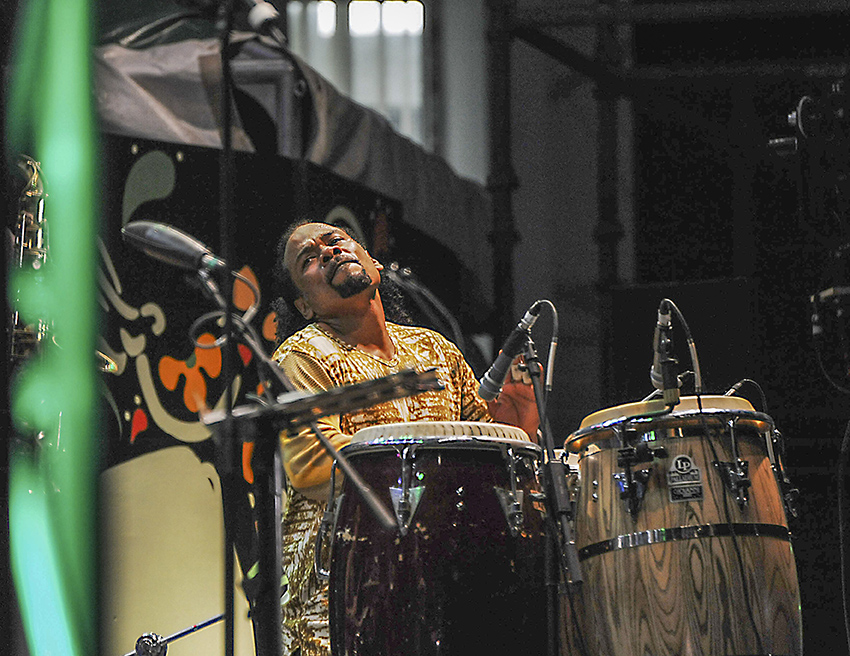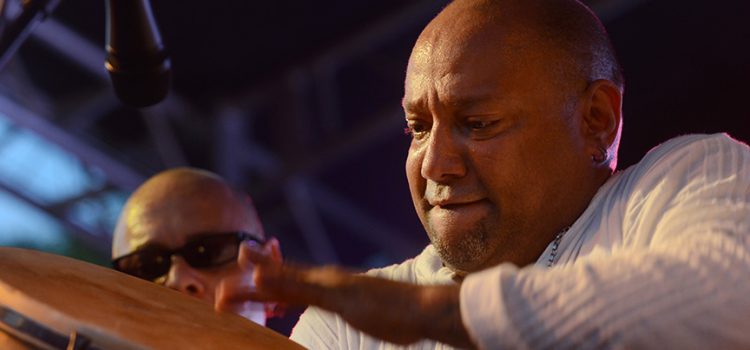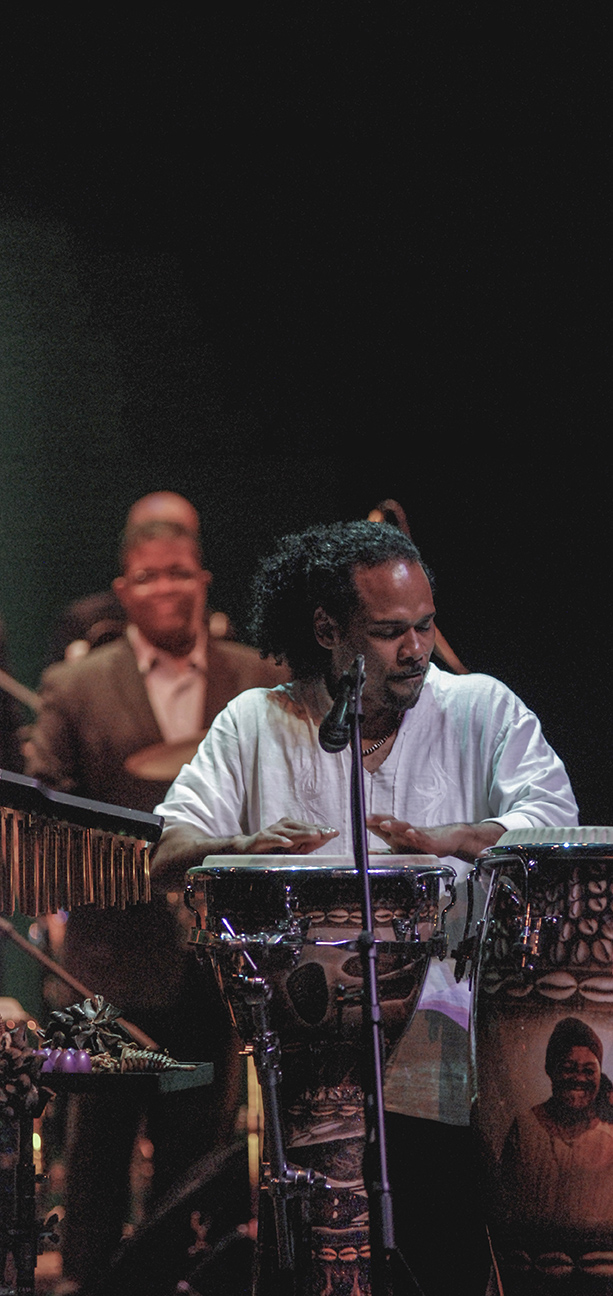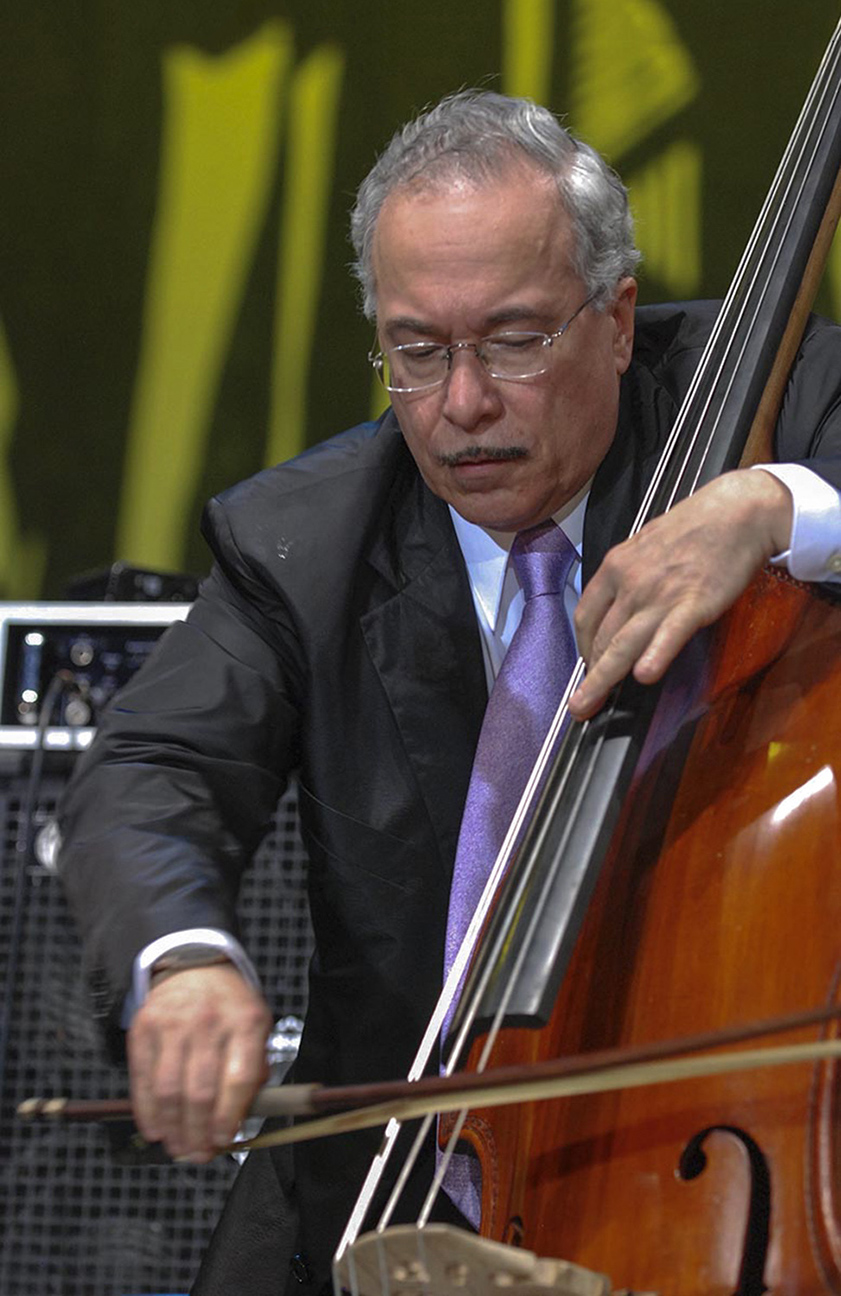From contemporary jazz, to Carlos Santana’s Latin rock band,
to World Music; Puerto Rican top performers weave
traditional local sounds into a diverse musical production.
Two sax players – David Sanchez and Miguel Zenon- have established themselves as stars of the contemporary international jazz scene. Paoli Mejias, a master conga drummer, has paused in his solo career to travel the world as a multi-percussionist for Carlos Santana. And Tito Matos has been a critical figure in the renewed vitality of the Afro-Puerto Rican plena tradition and its contribution to World Music.
The quality and success of these performers solidify Puerto Rico’s ability to produce world-class musicians.
Sanchez and Zenon: from humble beginnings to world’s jazz elite
David Sanchez and Miguel Zenon, both jazz sax players, composers, and bandleaders; grew up and started their musical education in Puerto Rico. Both settled in New York City, where they developed highly successful careers and became international stars in their own right.
Sanchez, who is 48, has the looks and moves of a 28-year-old athlete. He walks into La Junta, a small club in Santurce’s Loiza Street checking messages on his cell phone, greeting friends and fans with a shy smile, wearing bright green sneakers, black slacks, and polo.
After a while, the leader of the local jazz trio performing that night calls Sanchez on stage, and he plays two tunes ending with a vibrant, engaging solo that sends the crowd its feet. It is a feature guest performance, and a sort of aperitif to promote his concert “Carib” — a blend of Afro Caribbean, Haitian, and Puerto Rican influences — held the following weekend at Old San Juan’s historic Tapia Theater.
After high school, Sanchez won a scholarship to study music in Rutgers University in New Jersey where he took classes with masters like Kenny Barron and Ted Dunbar. Soon Sanchez jumped into the New York jazz scene with pianists Eddie Palmieri and Hilton Ruiz, and trumpeter Claudio Roditi.
But his career took off at 23 when he was recruited to play in the Dizzy Gillespie United Nations Orchestra. Mentored by the legendary Gillespie, Sanchez toured 27 countries and a hundred U.S. cities in three years with the band, drawing attention as the ensemble’s young virtuoso tenor sax player.
Sanchez went on to record eight albums as leader of his ensemble and earning six Grammy Award nominations. He won a Grammy for the CD “Coral” in 2005. Four of his releases have been named Billboard top jazz albums.
The CD “Carib,” which will be the first volume of a series, is scheduled to be released this year.
“The concept is a fusion of the Congo-Guinea traditions of Haiti with variations of the different Bomba rhythms and chants of Puerto Rico. It’s not only the rhythms but also the melodies and cadence of these folkloric songs that have inspired me,” he explained. Haitian music had a significant influence all over the region from Puerto Rico to New Orleans, he adds.
Last April Sanchez released the single “Canto,” inspired by Haitian folk chant. It is a haunting and intimate tune he dedicated to the memory of his wife Karla Davis Sanchez, who passed away at age 50 in August 2017.
Sanchez grew up in the town of Guaynabo listening to his parents’ records of classic Latin music greats from the 50’s and 60’s like Machito’s Orchestra and Tito Rodriguez’s big band. He sang with his mother and brothers in the church choir and began playing the conga drum at eight-years-old but took up the tenor sax at school by the time he was 12.
In high school, he got a hold of some Miles Davis, and John Coltrane records were wholly absorbed into jazz. “I wasn’t thinking about making it as a professional musician. I just loved it so much, and that journey took me to that path and next thing I knew I was playing with famous guys and thinking to myself hey I didn’t know I was going to get paid for this,” Sanchez recalled laughing.
The Grammy Award winner emphasizes the need to invest in art education on the island. He praises San Juan’s Free School of Music, where he and Zenon also studied.
“That’s a treasure, and you have to invest in it,” he said. “The graduates of that school play the first chair in the New York Philharmonic, like clarinetist Ricardo Morales. You have bassist Eddie Gomez, myself, Miguel Zenon in jazz. In other genres, from (rapper) Tego Calderon to (salsa singer) Gilberto Santa Rosa, are you kidding me? What governor or businessman can say they have had that much influence outside of Puerto Rico? Just think about it.”
After kicking off his tour in San Juan, Sanchez ended 2016 introducing his “Carib” project in Barcelona, Paris and the Jazz in Marciac festival in southern France. That year he performed as a featured special guest in the International Jazz Day Concert in the White House hosted by then-president Barrack Obama and First Lady Michelle Obama.
Earlier in March 2017, Sanchez performed in Puerto Rico Heineken Jazz Fest, the island’s most important yearly jazz event, which also featured Miguel Zenon’s Quartet.
He has continued presenting “Carib” throughout 2018 in concerts in San Francisco, Santa Monica, Phoenix, in the Earshot Jazz Fest in Seattle, and in Chicago’s Jazz Showcase. Sanchez alternates this activity with national and European tours with the San Francisco Jazz Collective, an all-star ensemble, of which he has been a member for the last five years.
The San Francisco-based collective has included Bobby Hutcherson and Joe Lovano among its members. Sanchez performs side by side with fellow Puerto Rican star Miguel Zenon, one of the founders of the group in 2004.
Zenon, who just turned 41, has a similarly brilliant career as an alto sax master, leader, composer, arranger, and educator. In 1996 he went to Berklee School of music in Boston after he decided not to accept a scholarship at the University of Puerto Rico at Mayaguez Engineering School, to pursue his musical goals.
After he graduated, Zenon went to New York and completed a Masters Degree in Performance in 2001 at the Manhattan School of Music starting a brilliant career playing with the David Sanchez group. He was mentored in this early stage by Sanchez, who was already established in the New York City and international jazz scene and had been impressed by Zenon’s talent since they met in Boston.
The path hasn’t been easy for Zenon who was born and raised until the age of 12 in San Juan’s Llorens Torres public housing project, one of the toughest in the city. Intelligence, talent, and hard work have been his recipe for success. “When I finished high school in 1994, there was no formal education in jazz in Puerto Rico, so I had to go out, but I didn’t have the money. Then I spent a couple of years searching for funding and working to save some money by doing all kinds of gigs; dance bands or whatever came up and teaching until I was able to get into Berklee,” Zenon remembered.
At the age of 24, Zenon started his recording career as a bandleader with a bang. The Miguel Zenon Quartet’s debut album, Looking Forward, was selected by the New York Times as the Alternative Jazz Recording of the Year.
Zenon has kept producing great recordings and performances in the U.S and worldwide receiving critical acclaim and obtaining multiple Grammy nominations. Jazz Review magazine All About Jazz hailed his second album, “Ceremonial” (2004) as a “head-on crash of Latin, Jazz and Classical traditions–modern Jazz at it’s very best.”
This mixture and exploration of influences is a big part of Zenon’s career as it is also true about that of Sanchez. In 2008 Zenon became a MacArthur Fellow, and the institution described him as “creating an entirely new jazz language for the 21st Century.” A fellowship from the Guggenheim Foundation supported his album, “Esta Plena,” exploring the traditional plena rhythm of Puerto Rico.
Zenon explores multiple angles with straight-ahead jazz, classical and Latin jazz and Caribbean folk influences but he sees it as a reflection of where jazz music stands today. “I’m from a generation that grew up around very global and inclusive jazz; one that is opened up to include information that comes from other art forms, like literature. It’s the time we live in, and the music reflects that. It also reflects my need to discover myself as a Puerto Rican, as a Latin American musician in the jazz scene and to see what I have to give,” Zenon explained.
The Miguel Zenon Quartet has been together for 15 years and features drummer Henry Cole, also from Puerto Rico, Venezuelan pianist Luis Perdomo, and Austrian-American bass player Hans Glawischnig-Klavishnik with Zenon on alto sax. Their last album, “Típico,” was released in February 2017 and has been played by the quartet in Europe, America, and Puerto Rico.
One of Zenon’s favorite projects is the Cultural Caravan, a series of free concerts that he produces in rural small towns on the island, introducing the classics of jazz to audiences that generally are not exposed to this music.
“We have done eleven concerts in five years, and I really enjoy it,” says Zenon, who usually starts with an educational talk about the music they will perform and organizes the Caravan with money from donations and out of his own pocket. “We use jazz to expose a cultural experience to society; I do it with jazz because that is what I can offer, so I see it as a cultural investment.”
Zenon continues to tour with the S.F Jazz Collective, where he is the senior member and only remaining founder. In May, the ensemble finished the Spring Tour with gigs in New York’s Jazz Standard, Detroit, Denver, and San Francisco, where they played originals together with arrangements by Miles Davis. In October, they will put together a new season dedicated to the music of Brazilian composer Carlos Antonio Jobim and kick off their Fall Tour on the West Coast and two weeks of concert dates in Europe.
Zenon, who is also a professor at the prestigious New England Conservatory of Music in Boston, will release a new album in late September of his compositions for Alto Sax and String Quartet titled “I am the Tradition.”
“It combines jazz elements, contemporary music and folklore inspired in several Puerto Rican musical traditions such as the Rosary songs, the Three King’s Promesas, among others, and I’m very excited about it,” he said.
Tito Matos, all about the roots
Tito Matos is the leader of Viento de Agua, a band that will impress music fans in any part of the world with their afro Caribbean rhythms mixed with sharp jazzy arrangements and a pulsing beat.
In 1994 Matos went to City University of New York to study landscaping but began playing with Los Pleneros de la 21, New York’s leading plena group. He made a name for himself in the big city. In the ten years, he has lived in New York; Matos has collaborated in musical fusions with pop superstars, jazz artists, and Salsa greats.
Those gigs include a Latin percussion performance with Celine Dion and Gloria Estefan at Radio City Music Hall and performances and a recording with Puerto Rican mega pop star Ricky Martin.
In 1997, Matos founded Viento de Agua with reedman and arranger Ricardo Pons. The 13-piece band created essential pathways in the evolution of Puerto Rico’s bomba and plena African rooted genres.
Matos returned to Puerto Rico in 2004 and reconstructed Viento de Agua on the island where it remains active. The band has released three albums and work in two different formats – the 13-piece group and a smaller version of six or seven players.
A third version of the ensemble, dedicated to straight ahead plena music, is made up of pandereta drums and chants. It mainly does gigs at pubs, small clubs or folk music events and is known as La Maquina Insular.
Matos, known for his engaging onstage persona, is highly regarded around the world as a premier performer and expert in bomba and plena and other Caribbean rhythm’s. Last year the 49-year-old musician was at Austria’s Vienna University offering workshops for music teachers. In France, he also conducted workshops and played the music for dance performances. His Viento de Agua band has been featured in the American Folk Music Festival in Bangor, Maine, and the Smithsonian Folk life Festival in Washington D.C., which is considered the premier world music festival.
Matos has also increased his touring activity outside of Puerto Rico. “We have just returned from a tour that took us to New York, Chicago, and San Francisco. In June, we’ll be in Maryland with La Maquina Insular, and in September we’ll be performing with our large band, Viento de Agua, in the North Carolina Folk Festival in Greensboro, so we’re on the move. The Puerto Rican diáspora in the U.S. has been very supportive of local musicians, especially those of traditional genres, inviting us to perform and even funding events in the island,” Matos explained.
One of the things Tito Matos enjoys about performing his music for an international audience is that people from very different countries and cultures will respond enthusiastically to the mix of plena and other Caribbean sounds that his ensembles play.
“Plena has a simplicity to it. And when it is well played, when you get to feel it, it enters through your feet, gets into your belly, and you need to move and dance,” Matos said with a laugh.
Paoli Mejias – master drummer,on tour with Santana
Paoli Mejias never took a music lesson in his life. His love at first hearing with the sound of the Conga drums sparked an obsession that led him to become one of the foremost Conga drummers in the world and a master of multiple percussion instruments from different cultures.

Plaza del Quinto Centenario (Quincentennial Plaza) was inaugurated in 1992 to celebrate the 500th birthday of the founding of the New World by the Spanish.
“It was an instinctive thing. When I heard the drums as a kid, I suddenly felt so connected to that sound. I felt the need to have a drum and play it. I got myself a little conga drum and just imitated the sounds I heard in records. I didn’t even have this dream about being a musician. I just did it because I felt passionate about it and would play all day without stopping until my family begged me to stop at night,” Mejia remembered with a broad smile.
By age 14, Mejias had moved to Toa Baja where he began to play with a Calypso group in the hotels of Dorado, and at 17 he participated in legendary rumba jam sessions in Rio Piedras with conga masters Giovanni Hidalgo and Richie Flores. Mejias jumped to the big stage at age 23 as a bongo and conga player for multi-Grammy laureate, salsa, and Latin jazz bandleader Eddie Palmieri. “There I made a name for myself because I was featured as a conguero doing many solo improvisations. We did France, Germany, UK, Spain, all of Europe and the U.S.,” he said. Reedman Paquito D’Rivera and pianist Chick Correa are among the other jazz greats with whom Mejias has performed.
In 2005 Mejias decided to go his own way and formed the Paoli Mejias Latin Jazz Quintet and released three independent albums. The first one “Mi Tambor” was nominated for a Latin Grammy in the Latin Jazz category competing with legends as Poncho Sanchez and Cuban pianist Bebo Valdes. For several years the quintet played on the international jazz circuit of festivals and clubs.
“I put together my own group because I like to break old patterns and rules and I hate doing the same things, the same way all the time,” said the 47-year-old percussionist. “I tried to incorporate other musical influences into the conga playing, sounds from India, Greece, Africa and Puerto Rico, for example. It used to be that Latin jazz congueros did mostly Afro-Cuban jazz more or less but I wanted to expand that, and I did.”
Then Mejias paused his career as a bandleader to accept an invitation he could not refuse. In 2013, he was recruited as the conguero and multi-ethnic percussionist in the band of legendary Rock guitarist and pioneer of the Latin Rock sound, Carlos Santana. For several years, Santana had used different percussionists and was searching the right person for a steady job, and he found Paoli.
“This is a big organization led by a megastar,” notes Paoli. “And it requires certain energy, a positive attitude on stage, and they found this in me. Carlos says that he sees the light in me, those are his words, not mine,” he laughed. “He told me that he sees in me something he expects of band members: to be someone that adds positively not only in the music but in the good energy, the discipline, the ability to get along with the rest of the band, and the idea is that this energy projects itself on the stage to the audience and everybody can feel it,” Mejias added.
The Santana band is always on tour doing 40 concerts a year in Las Vegas’ Mandalay Bay House of Blues where Santana is a resident artist. Mejias and wife Sarah Vogel recently bought a house in her hometown of Seattle, and they live part of the year there and part in Puerto Rico.
But most of the time Mejias is in Vegas or on the road with Santana and is continuously on the move. This year Mejias played with Santana in Bahrain, United Arab Emirates, as part of the major Grand Prix race, and toured South Africa, with concerts in Johannesburg and Capetown. “In two weeks we’ll be with Santana in Las Vegas where we do four months a year, and we will have two European Tours in the rest of 2018 that include cities in Spain, Italy, France, Finland, and Norway among others,” the master percussionist explained.
“I see this stage with Santana as a parenthesis in my career as a group leader, and at some point, I’ll be back because it’s important for me to be able to display my musical creativity and concepts to the fullest extent,” he said. But no matter how hectic and demanding his calendar with Santana may be, Mejias he has kept producing original music and releasing various single tracks.
“Then I realized I have enough material for a CD so I am working on the final mixing of two of those tracks and it will be ready for release this year,” he said. “My previous albums have been mostly of jazz music, but these have some salsa tracks, and also my original fusions and invented polyrhythm. They all have music and lyrics written and performed by me,” Mejias added.
“Oh, I forgot to tell you, my signature conga with Latin Percussion just came out, it’s called ‘Jazzambia,’ the name of one of my first recordings.” LP signature congas are considered a sort of Hall of Fame distinction for Conga drummers. “What’s so unique is that I was able to design my signature conga, which is not how it usually works, so I’m very happy about it.”




